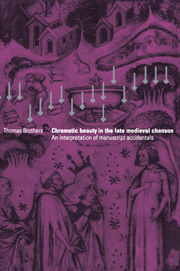3 - MSS Chantilly Musée Condé 564 and Oxford, Bodleian Library Canonici Misc. 213
Published online by Cambridge University Press: 02 November 2009
Summary
Our focus now shifts from the work of a single composer back to a broad and diverse repertory that includes the work of many composers, some anonymous and most barely identifiable. Consequently, we also turn back to an emphasis on anthologies. Most of the songs discussed in this chapter were copied into one of two large and important sources for polyphonic music from the decades surrounding 1400 – MS Chantilly, Musée Condé 564 (c. 1410–15) and MS Oxford, Bodleian Library, Canonici Misc. 213 (c. 1426–36). These sources are justly famous, Chantilly 564 as a spectacular repository of complicated late fourteenth-century songs and Oxford 213 as a wide-ranging anthology that is crowned, on its most recent end, by 40 of Du Fay's early songs. Chantilly 564 includes earlier music going back to Machaut, and Oxford 213 has music dating as early, perhaps, as the 1370s. Thus, the two anthologies yield a wide chronological range, suiting well our purpose of sampling the use of accidentals between Machaut and Du Fay.
There survives from this period a considerable quantity of music, yet we know relatively little beyond the bare notes on the page, and much of the context for the music remains obscure. Rarely do songs survive in more than one or two manuscripts. More than occasionally, one discovers good reasons to question the reliability of sources, which, as a rule, preserve a repertory that is eclectic both geographically and chronologically. Chantilly 564 and Oxford 213 were both copied in northern Italy, and most of their songs that will be of interest to us here were probably composed elsewhere; these Italian manuscripts are, in fact, our two main sources for French music during…
- Type
- Chapter
- Information
- Chromatic Beauty in the Late Medieval ChansonAn Interpretation of Manuscript Accidentals, pp. 136 - 184Publisher: Cambridge University PressPrint publication year: 1997



